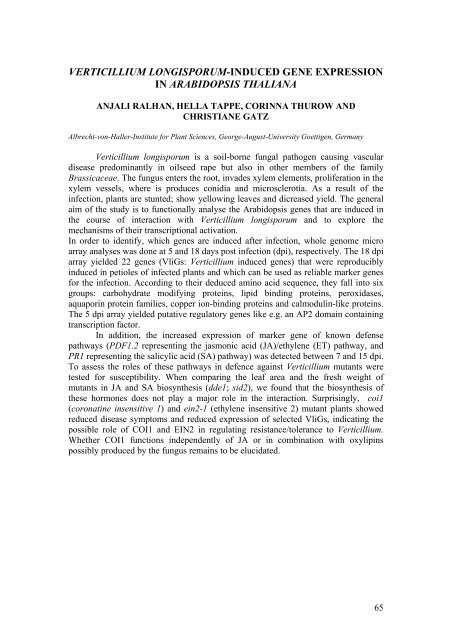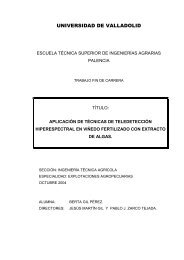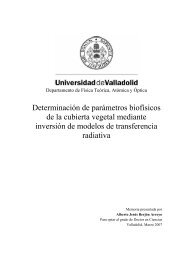10th INTERNATIONAL VERTICILLIUM SYMPOSIUM 16-20 ...
10th INTERNATIONAL VERTICILLIUM SYMPOSIUM 16-20 ...
10th INTERNATIONAL VERTICILLIUM SYMPOSIUM 16-20 ...
Create successful ePaper yourself
Turn your PDF publications into a flip-book with our unique Google optimized e-Paper software.
<strong>VERTICILLIUM</strong> LONGISPORUM-INDUCED GENE EXPRESSIONIN ARABIDOPSIS THALIANAANJALI RALHAN, HELLA TAPPE, CORINNA THUROW ANDCHRISTIANE GATZAlbrecht-von-Haller-Institute for Plant Sciences, George-August-University Goettigen, GermanyVerticillium longisporum is a soil-borne fungal pathogen causing vasculardisease predominantly in oilseed rape but also in other members of the familyBrassicaceae. The fungus enters the root, invades xylem elements, proliferation in thexylem vessels, where is produces conidia and microsclerotia. As a result of theinfection, plants are stunted; show yellowing leaves and dicreased yield. The generalaim of the study is to functionally analyse the Arabidopsis genes that are induced inthe course of interaction with Verticillium longisporum and to explore themechanisms of their transcriptional activation.In order to identify, which genes are induced after infection, whole genome microarray analyses was done at 5 and 18 days post infection (dpi), respectively. The 18 dpiarray yielded 22 genes (VliGs: Verticillium induced genes) that were reproduciblyinduced in petioles of infected plants and which can be used as reliable marker genesfor the infection. According to their deduced amino acid sequence, they fall into sixgroups: carbohydrate modifying proteins, lipid binding proteins, peroxidases,aquaporin protein families, copper ion-binding proteins and calmodulin-like proteins.The 5 dpi array yielded putative regulatory genes like e.g. an AP2 domain containingtranscription factor.In addition, the increased expression of marker gene of known defensepathways (PDF1.2 representing the jasmonic acid (JA)/ethylene (ET) pathway, andPR1 representing the salicylic acid (SA) pathway) was detected between 7 and 15 dpi.To assess the roles of these pathways in defence against Verticillium mutants weretested for susceptibility. When comparing the leaf area and the fresh weight ofmutants in JA and SA biosynthesis (dde1; sid2), we found that the biosynthesis ofthese hormones does not play a major role in the interaction. Surprisingly, coi1(coronatine insensitive 1) and ein2-1 (ethylene insensitive 2) mutant plants showedreduced disease symptoms and reduced expression of selected VliGs, indicating thepossible role of COI1 and EIN2 in regulating resistance/tolerance to Verticillium.Whether COI1 functions independently of JA or in combination with oxylipinspossibly produced by the fungus remains to be elucidated.65




